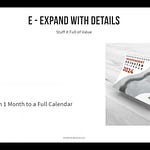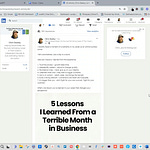Yes! Your lead magnet worked—you’ve got a list of people interested in your topic and your points of view. Now, the big questions come up. What should you email them? And how often?
Over the last seven-plus years, I have made it super complicated. But eventually, I found what works best for me. Systematically emailing my weekly deep dive gives me the best results. I choose a topic I’ve discussed earlier in the week as a social media post, and then I expand on that.
With this experience in mind, I developed a framework for your weekly deep dive. And I just came up with the perfect name: the REFLECT Email Method.
You REFLECT on your previous posts and use them to email your audience.
Here is the breakdown:
R – Review posts
E – Extract additional insights
F – Find more angles
L – Link to personal experience
E – Expand with details
C – Call to action
T – Tie back to core framework
I’ll walk you through each of these steps. On the way, I’ll refer to the following example.
A while ago, I created a LinkedIn post about what work opportunities new independent insurance adjusters can expect at this time of year. From the responses, I could tell this was a topic more people wanted to know about. I wrote an email about what an adjuster could expect each month of the year. Later, I packaged a lead magnet called the Independent Adjuster’s Calendar, which would form the basis for my weekly email deep dive.
Let’s REFLECT on the process.
R – Review Posts
Begin by revisiting your recent social media engagements.
Scrutinize last week’s posts and note which garnered the most interaction and attention. Identify what topics and styles resonate with your audience and pinpoint their interests. You can use your past content as a guide for future emails.
Your previous posts are more than just updates; they’re a compass pointing toward your audience’s preferences.
There are three metrics you can glean from most social media platforms:
Likes and other engagements
Comments
Shares
The strongest indicator of topic potential is shares. A share means someone thinks your post is worth their association and the space on their virtual walls. If you see this happening when you post a particular type of content, follow that trail.
Comments show that people like to add to the conversation. Likes are almost worthless as a metric because it’s hard to know why people liked the post and whether they read it.
So, choose the posts with the most comments and shares.
E – Extract Insights
Now, take your time to examine the posts in front of you. Why did your audience show more interest in those than other posts? This goes beyond surface-level metrics. If you read the comments carefully, you’ll open the book to your followers’ minds—you can read their needs and interests, discover the core reasons behind the engagement, and dive deeper into what resonates with your audience.
Take those new insights, and stuff your emails with the things your followers liked best. If they enjoyed a post about your computer setup, they might love an email breaking down your workday schedule.
You’re on a fact-finding mission. Find what your followers want, and give them more of it.
F – Find More Angles
Expand the scope of your successful posts.
When a topic like “How Much Work You Can Expect To Get in January as an Independent Adjuster” resonates, brainstorm how to broaden this discussion. Could you provide a year-round perspective or relate it to industry trends? This approach not only diversifies your content but also demonstrates your knowledge and insight.
Exploring various angles keeps your content fresh and your audience engaged. Ask yourself, “But what else?” and you’ll find new directions.
Your audience wants you to add value by thinking ahead for them. You are solving their problems, often before they’re even aware of them—helping them avoid failure.
Look at their situation. What angles should they be made aware of?
L – Link to Personal Experience
Did you ever see people lean toward you when you talked about your life? They felt part of your inner circle, entrusted with something special. By weaving your personal stories and experiences into your content, you’ll make your customers lean in just like that. Your message will feel authentic and help build a deeper connection with your audience.
If your post about “How Much Work to Expect in January” resonates, you could share a story about how you spend your January. You could tell about acquaintances who survived fluctuating work volumes. You could show that others had the same problems—and overcame them. This is dynamite compared with simply offering a solution or concept.
Seeing it lived out gives your audience hope.














Share this post